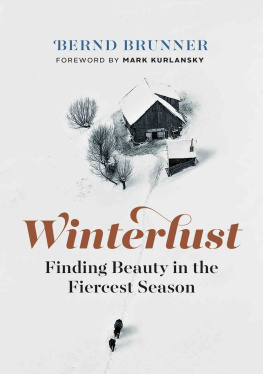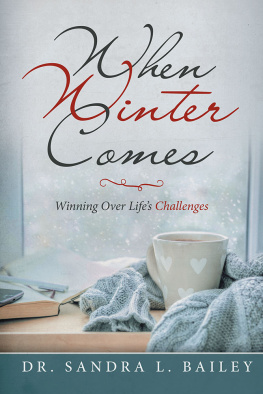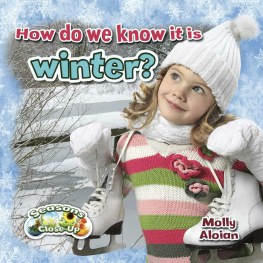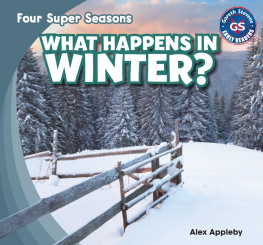First published in North America in 2019 by Greystone Books
Originally published in Germany by Verlag Galiani Berlin as Als die Winter noch Winter waren: Geschichte einer Jahreszeit
Copyright 2016 by Verlag Kiepenheuer & Witsch, Cologne
Revised text for the English edition copyright 2019 by Bernd Brunner
Translation copyright 2019 by Mary Catherine Lawler
Foreword copyright 2019 by Mark Kurlansky
Illustrations copyright as credited
19 20 21 22 23 4 3 2 1
All rights reserved. No part of this book may be reproduced, stored in a retrieval system, or transmitted, in any form or by any means, without the prior written consent of the publisher or a license from The Canadian Copyright Licensing Agency (Access Copyright). For a copyright license, visit www.accesscopyright.ca or call toll free to 1-800-893-5777.
Greystone Books Ltd.
www.greystonebooks.com
Cataloguing data available from Library and Archives Canada
ISBN 978-1-77164-352-8 (cloth)
ISBN 978-1-77164-353-5 (epub)
Editing by Jane Billinghurst
Copyediting by Paula Ayer
Proofreading by Jennifer Stewart
Jacket and text design by Belle Wuthrich
Jacket photograph by Lazar Ioan Ovidiu
Frontispiece: Priests twirling in the snow, 196163
Extract from Kaputt by Curzio Malaparte quoted with permission. Copyright 2005 by Comunione Eredi Curzio Malaparte, Italy. Translated from the Italian by Cesare Foligno. Published in English by New York Review of Books. All rights reserved. Extracts from John C. Charyk, Syrup Pails and Gopher Tails and The Little White Schoolhouse reproduced with the kind permission of the Estate of John C. Charyk.
Greystone Books gratefully acknowledges the Musqueam, Squamish, and Tsleil-Waututh peoples on whose land our office is located.
Greystone Books thanks the Canada Council for the Arts, the British Columbia Arts Council, the Province of British Columbia through the Book Publishing Tax Credit, and the Government of Canada for supporting our publishing activities.
The translation of this work was supported by a grant from the Goethe-Institut, which is funded by the German Ministry of Foreign Affairs.

Contents
by Mark Kurlansky

Falling snowflakes entice us to play, early twentieth century.

Horse-drawn sleighs race across the snow, ca. 1870.
Foreword

I T DOES NOT require an intense study of history, science, and the development of civilization to see that humans have a clear preference for heat over cold. Consider, for example, that people learned to make ice millennia after they first made fire. Moreover, despite the fact that heating has been available for far longer than air conditioning, they have always been more drawn to hot countries than to cold. Perhaps this is because plants grow better in heat? And yet, hot doesnt always mean food: more fish live in cold seas than in warm ones.
For centuries, the origins of cold were a mystery. Aristotle believed it originated in water. The seventeenth-century scientist Robert Boyleconsidered the first chemist in the modern sense of the wordeasily disproved this idea by pointing out that many substances that lacked any water could become very cold. Rock and metal come to mind. Still, Aristotles erroneous theory seems less improbable than the widely held medieval European belief that cold originated in a place called Thule, an uncharted island in the middle of the Atlantic.
It has often been suggested that the reason humans more readily embrace heat than cold is because heat is associated with life and cold with death. Of the four seasons, spring, the season of birth, is the favorite and summer is much loved. Fall is wistfully reflected upon as a poetic tragedy and harbinger of the death that is to come in those tough few months of winter until, at last, we once more get to spring.
Even I, I admit, shared the common bias toward heat, and it took me many years to grasp the fact that people and cultures in the extreme cold are as rare, exotic, and fascinating as those in the tropics.
This fascination is the core idea in Winterlust. For those with winterlust, the season lays down its challengeschiefly how to devise strategies to survive it. Bernd Brunner covers these, to be sure, but he also revels in more lighthearted topics such as the structure of snowflakes; the science, history, and technology of the snowman; and the playful glow of a welcoming hearth.
There have always been those consumed by winterlust. The Russians, for example, are famous for their love-hate relationship with snow. Tolstoys memorable story Master and Man is all about an aristocrat and a serf lost in a blizzard. But Brunner reminds me that there is a more extensive winter literature out there. He quotes from my favorite passage of James Joyce at the end of Dubliners, about snow falling in Ireland, and he demonstrates that while not often remembered for this, the New England Transcendentalistschiefly Ralph Waldo Emerson and Henry David Thoreauwere great winter enthusiasts.
Their predilection for this season is not surprising since before beach holidays became the fashion, New England was mostly associated with winter. Indeed, the early European explorers of eastern Canada and New England postulated that the winter in those regions was so harsh that the area was unsuited for habitation, which is a curious observation when you consider that the area was inhabited when they arrived. There have always been people who know how to live in extreme winter, but temperate-zone people have tended to ignore them.
The New England literature and art I am familiar with is full of winter, including John Greenleaf Whittiers morose poem Snow-Bound, where a cheerless sun rises over hills of gray. But, as Brunner points out, winter also inspires, for it can be dazzlingly beautiful. Rockwell Kent, though a New Yorker, was driven to New England, Newfoundland, Greenland, and Alaska by a winterlust that produced stunning moonlit snowscapes, dramatic portraits of ice drifts, and his starkly illustrated account of a voyage to Greenland, N by E.
Reflecting on the work of Kent goes some way to gaining an understanding of the dramatic pull of winter. But better yet, read the insights offered by Brunner in Winterlusts wide-ranging exploration of the challenges and charms of the cold season.
MARK KURLANSKY, author of Salt: A World History and Cod: A Biography of the Fish that Changed the World

Winter fun on Boston Common, ca. 1856


















